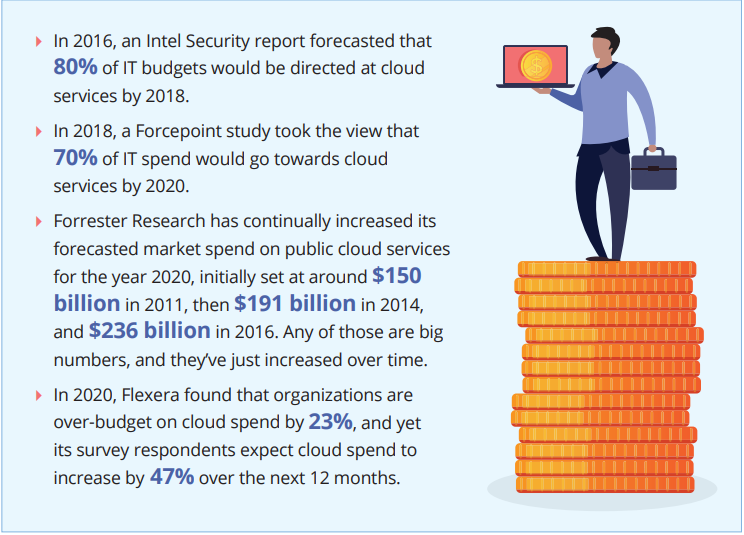The Increasing Problem of Cloud Services Sprawl

Learn how to fully harness the power of Microsoft 365 with our latest ebook “Consolidating Cloud Services and Fully Leveraging Microsoft 365.“
Read our other posts on cloud consolidation below:
- 5 Ways Microsoft 365 Streamlines Your Cloud Services
- Preparing for Microsoft 365: 3 Vital Steps
- How to Handle Microsoft 365 Migration Pitfalls
The health pandemic of 2020 has further driven the sprawl of cloud services, but the migration to the cloud has been building steadily over the past decade. Let’s look at the evidence.
Number of Cloud Services
Many research reports highlight the fact that organizations are using multiple cloud services. Out of a sea of numbers, here’s four:

There’s a big difference between Intel’s 43 number in 2016 and the other data points between 1,000 and 2,000. While some of this variation will be due to the growth in usage of sanctioned services, the higher numbers are also likely to count separate instances of the same cloud service and shadow IT services.
For example, if ten separate groups are using Dropbox for Business, that’s counted as ten services. The higher numbers also count unsanctioned cloud services, hence quantifying the magnitude of shadow IT as a problem in modern enterprises, particularly since Forcepoint, Microsoft, and McAfee each offer cloud discovery capabilities in their respective cloud security offerings.
In summary, irrespective of the actual number of cloud services currently in use in the average enterprise, these very high numbers illustrate that cloud services have been widely and broadly adopted in both sanctioned and unsanctioned modes. But more importantly, these numbers raise significant questions around governance, information risk, security, productivity, and cost-effectiveness.
Spending on Cloud Services
Moving to cloud services offers a way to transform monetary flows from capital to operational budget line items, reduce expenditure overall, and enable greater agility. And organizations are going for it. Consider:

In its research, Forcepoint also said that 40% of cloud spend goes towards unsanctioned apps (also called shadow IT services). It’s not hard to see this if we consider the massive variation in the McAfee findings from 2019 above: organizations are using “about 30” sanctioned apps and “about 1,905” unsanctioned ones. An earlier study in 2017 by McAfee found the following concerning the use of overlapping services:

Earlier in 2020, an analysis by Flexera found that organizations are wasting at least 35% of their cloud spend. It is no surprise, therefore, that optimizing the use of existing cloud services is the highest cloud-related priority across Flexera’s survey base.
Closing Thoughts
It would not be inappropriate to use the findings above to make this conservative assertion: at least 40% of cloud spend is overlap, which therefore gives us a ballpark for the magnitude of cost savings available from cloud consolidation. A less conservative estimate would be in the 70-80% range.
Cloud is an increasingly dominant factor in IT budgets—and in business group budgets too, once unsanctioned app expenditures are counted. As an overall entity, each organization has the responsibility to ensure their IT spend is optimized and delivers effective outcomes.
The use of cloud services is not going away. Cloud services have become a strategic approach for how IT services are delivered across the organization, and as such, a better strategy for cloud service selection and adoption is essential.
Download the full ebook to learn how to avoid sprawl and harness the power of the cloud efficiently.
For more insights on Microsoft 365 and cloud services as a whole, be sure to subscribe to our blog.
As the former Content Marketing Specialist for AvePoint, Brent led the strategy and direction of all AvePoint's blog properties.



